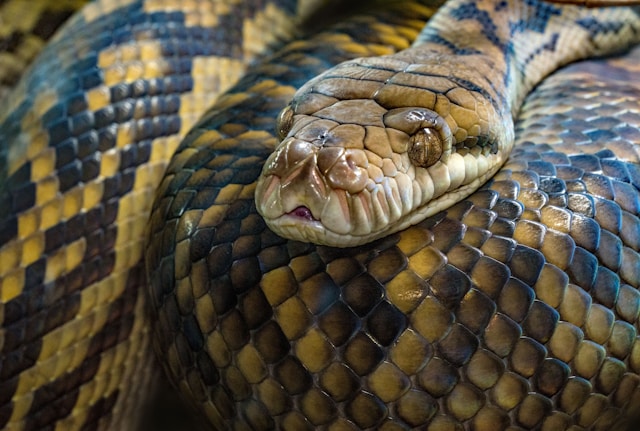A recent study of Burmese pythons concludes that snake meat is more efficient to produce than traditional livestock, making it a viable protein alternative to cows or pigs. Given the primeval human aversion to snakes, this menu item may be a harder sell even than crickets or faux-meat nuggets. However, the omissions and biases inherent in the study’s conclusions reveal much larger impediments to snake burgers than diner aversion.
Snake Bait and Switch
The study of Thai and Vietnamese farms offers some interesting data about reptilian biology, and certainly, snake as a specialty meat product is a perfectly sensible menu item – as is alligator, turtle, or eel. However, the suggestion that humanity should convert from tens of thousands of years of symbiotic animal husbandry to an ophidian diet is a fantastical and unworkable “replacement theory.”
The plug for snake meat smacks of snake oil. A hint is offered in the deceptive statement by proponent Daniel Natusch from consulting firm EPIC Biodiversity, who proclaims that “no other livestock species studied to date possesses the same credentials or rates of production as pythons.”
Natusch, whose academic expertise is in reptile biology, does not conceal his ideological bias, revealed in articles such as “The fatal flaws of compassionate conservatism” and his founding and leadership of the Australian charity People for Wildlife. Dr. Natusch premises his claim that snakes are superior to other farm animals on the study’s measurement of the conversion of energy into meat by the Burmese Python:
“According to the study, the dry mass of the food the pythons were fed was 1.2 times that of the dressed carcass, compared with 1.5 for salmon, 2.1 for crickets, 2.8 for poultry, 6 for pigs and 10 for beef.
“The dry mass of the protein fed to the snakes was 2.4 times that in a snake carcass, compared with 3 for salmon, 10 for crickets, 21 for poultry, 38 for pigs and 83 for beef.”
Neither a climate scientist nor a biologist is required to readily perceive a mismatch here: Snakes are carnivores that eat a high-protein diet of other animals that consume yet other animals and plants, whereas traditional “livestock” are mostly herbivores – mammalian ruminants who dine solely on protein-weak grasses and other plant forage.
What a Waste (of Breath)
When pressed about this “apples and oranges” analytical perversion, Dr. Natusch offered an equally specious excuse: It isn’t the efficiency of food conversion that makes snake meat sustainable, but the fact that snakes are fed on waste meat like trapped rodents and stillborn pigs. “Livestock fed on plant protein sourced from a crop monoculture where a natural habitat once stood … is far less sustainable than capturing rodent pests or using waste protein to feed pythons,” he said.
Dismissing his own study’s argument that snakes are grand for their food conversion, the snake doctor here pivots to a bold claim that trapped rodents and stillborn pigs can somehow compete with grass at scale and a strawman conclusion about livestock that ignores rotational grazing that nurtures the natural landscape. He also bypassed the fact that cows are fed agricultural waste products on a massive scale that would not be palatable to his pet pythons: fruit peels and pulp, corn refuse left over from the ethanol industry, spent brewery grains, almond hulls, etc. These are removed from a landfill destiny, where they prevent gaseous emissions from rot, reducing the output of crop waste by an estimated 60%, according to Gizmodo. Perhaps he will propose shipping this to Vietnam to feed wild rats?
Cows require 83 times the dry mass of protein because they extract it from plant matter, with very low concentrations of protein relative to rat or piglet sausages. Globally, humanity allegedly consumes about 350 million tons of meat annually. That is not just a lot of Burmese Pythons – by Natusch’s calculations, that equates to 840 million tons of dead rats and piggies – plus whatever they ate. (Someone, please send him a calculator!)
Rotational grazing is obviously far more sustainable, and it eliminates the chemical-dependent grain crops that destroy soils and pollute groundwater not just in monocultures for livestock feed but in plant-based diets (including synthetic meats) made from unsustainable (vegan) grain crops. Rats don’t eat grass – they eat grains. What will they be “sustainably” fed? We are not told by the snake charmers.
A Moral Argument?
Natusch dangles yet another savory tidbit of balderdash: the moral “case” for munching snake flesh in lieu of fried chicken or yummy bacon. Dr. Natusch again resorts to serpentine reasoning when plugging pythons over bovines: “For the vegans out there, in my experience, there would likely be more animals suffering from sowing crops into the soil each year than are killed to feed a python.”
He also argues that farming snakes is more ethical than farming birds or mammals since serpents lack the cognitive capacity of the other two and are more likely to remain inactive in small, confined spaces when they don’t need food. Both of these assertions fall to the ground on inspection. Whatever he means by “animals suffering from sowing crops” (the trope that farm animals lead unhappy lives, which is just not true of grass-fed cows and free-range chickens), it is hard to imagine that more cows and pigs are slain each year than the billions of rats his snakes need for sausages. Certainly there aren’t enough piglets, despite California’s Proposition 12, which ensures more piglets will die every day.
As to the moral argument, it seems there has been another twist in logic – Natusch admitted snakes aren’t really that efficient, switched to “they eat waste meat” (an impossibility at scale), and now turns to a moral persuasion that is divorced completely from the sustainability premise upon which the study was based. Far-left field is where all the climate shenanigans end up hitting their nutty balls.
Serpentine Food Security?
Perhaps most fantastical yet, Natusch finishes this tasty smorgasbord of weak assertions with the biggest Pinocchio of all: that snakes will increase food security because “most of the snakes chose to go for periods of up to 127 days without eating, yet lost just a few percentage points of body mass at most,” which “means that farmers can stop feeding them for weeks or months if there are global shocks that interrupt supply chains.”
Cows on grass are immune from such threats. Perhaps when global supply chains from Thailand and Vietnam (where shrimp farming is decimating the ecosystem) are disrupted, Americans won’t be able to import snake fare. Snakes may be content without food, but humans don’t do so well on 127-day fasts. Cows are kept locally, often on pastures unsuitable for growing plant crops. Rotationally grazed cows sequester more carbon than they emit, feed depleted soils with manure, and convert grasses to protein without the intervention of disease-carrying rodents. That is the current food security Natusch advises humanity to abandon in the name of snake food insecurity.
Or was it efficiency? Or sustainability? Or morality? Or preventing global warming? Or recycling waste?
Sensible minds prefer reliable, grass-fed, locally sourced beef and lamb. For those who buy into the reptilian argument that cows hurt the planet, perhaps we should just “Let them eat snake!”





